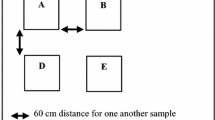Abstract
It is well known that wood species and particle size used influence the bending strength of three-layer particleboard. The objective of this study was to investigate the influence of using bagasse particles in surface layer on bending strength of three-layer particleboard panels. The ratio of the mixture of bagasse and wood particles was 3:7 and 4:6 in the surface and middle layers, respectively. Press temperatures were chosen at two levels of 165 and 180 °C. Three levels of urea formaldehyde resin were selected for the surface layers, namely: 8, 10, and 12 percent. Bending strength of the panels was determined according to the procedure of European Union (EN) Standard. The results show that bagasse has a positive effect on the bending strength of boards. In this research, the treatment with 40% bagasse and 12% resin in the surface layers and a 180 °C press temperature has resulted in an optimum bagasse board product.
Zusammenfassung
Es ist allgemein bekannt, dass die verwendete Holzart und die Spangröße einen Einfluss auf die Biegefestigkeit von dreischichtigen Spanplatten haben. In dieser Studie wurde der Einfluss von Bagassespänen für die Deckschicht auf die Biegefestigkeit von dreischichtigen Spanplatten untersucht. Das Verhältnis von Bagasse in den Deckschichten und Holzspänen in der Mittelschicht betrug 3:7 bzw. 4:6. Als Presstemperaturen wurden 165 und 180 °C und als Harnstoffformaldehydharzgehalte in den Deckschichten wurden 8, 10 und 12 Prozent gewählt. Die Biegefestigkeit der Platten wurde gemäß EN-Norm bestimmt. Die Ergebnisse zeigen, dass Bagasse einen positiven Einfluss auf die Biegefestigkeit der Platten hat. Im Rahmen dieser Untersuchung ergaben sich mit einem Bagasseanteil von 40 % und einem Harzanteil von 12 % in den Deckschichten und einer Presstemperatur von 180 °C optimale Ergebnisse
Similar content being viewed by others
References
Amir-Hosseini A (2001) Investigation on particleboard properties made of mixture reed and wooden chips. MSc Thesis, Tehran Uni, Iran
Ashori A, Nourbakhsh A (2008) Effect of press cycle time and resin content on physical and mechanical properties of particleboard panels made from the underutilized low-quality raw materials. Ind Crops Prod 28:225–230
Bektas I, Guler C, Kalaycıoglu H, Mengenoglu F, Nacar M (2005) The manufacture of particleboards using sunflower stalks (Helianthus annuus I.) and poplar wood (Populus alba L.). J Compos Mater 39:467–473
Buschbeck L, Kehr E, Jensen U (1961a) Untersuchungen über die Eignung verschiedener Holzarten und Sortimente zur Herstellung von Spanplatten – 1. Mitteilung: Rotbuche und Kiefer. Holztechnologie 2(2):99–110
Buschbeck L, Kehr E, Jensen U (1961b) Untersuchungen über die Eignung verschiedener Holzarten und Sortimente zur Herstellung von Spanplatten – 2. Mitteilung: Kiefernreiserholz. Holztechnologie 2(3):195–201
Copur Y, Guler C, Akgul M, Tascioglu C (2007) Some chemical properties of hazelnut husk and its suitability for particleboard production. Build Environ 42:2568–2572
EN 310 (1993) Wood-based panels, determination of modulus of elasticity in bending and bending strength. European Committee for Standardization, Brussels, Belgium
Gamage N, Setungea S, Jollandsa M, Hagueb J (2008) Properties of hardwood saw mill residue-based particleboards as affected by processing parameters. Ind Crops Prod (in press)
Guler C, Ozen R (2004) Some properties of particleboards made from cotton stalks (Gossypium hirsitum L.). Holz Roh- Werkst 62:40–43
Guntekin E, Karakus B (2008) Feasibility of using eggplant (Solanum melongena) stalks in the production of experimental particleboard. Ind Crops Prod 27:354–358
Güru M, Tekeli S, Bilici I (2006) Manufacturing of urea formaldehyde based composite particle board from almond shell. Mater Des 27:1148–1151
Heslop G (1997) Ten years of experience with commercial straw particleboard production. In: Wolcott MP, Miklosko LC, Lentz MT (eds) Thirty first international particleboard composite materials symposium proceedings, vol 31. Washington State University, Pullman, pp 109–113
Irle M (2000) An investigation of the influence of wood density on the reological behaviour and dimensional stability of hot-pressed particles. 12 str. (neobjavljeno)
Jossifov N (1989) Wechselbeziehungen zwischen der Dichte und wesentlichen physikalisch-mechanischen Eigenschaften industriell hergestellter mehrschichtiger Spanplatten aus Hartlaubholz. Holztechnologie 30(4):200–202
Kalaycioglu H, Nemli G (2006) Producing composite particleboard from kenaf (Hibiscus cannabinus L.) stalks. Ind Crops Prod 24:177–180
Karr GS, Cheng E, Sun XS (1999) Physical properties of strawboard as affected by processing parameters. Ind Crops Prod 12:19–24
Khedari J, Nankongnab N, Hirunlabh J, Teekasap S (2004) New low-cost insulation particleboards from mixture of durian peel and coconut coir. Build Environ 39:59–65
Malony TM (1993) Modern particleboard and dry-process fiberboard manufacturing. Freeman, San Francisco, 681 p
Moslemi AA (1974) Particleboard: materials, vol 1. Southern Illinois Uni. Press, Carbondale, 586 p
Nemli G, Demirel S, Gümüokaya E, Aslan M, Acar C (2009) Feasibility of incorporating waste grass clippings (Lolium perenne L.) in particleboard composites. Waste Manag 29(3):1129–31
Papadopoulos AN, Hague JRB (2003) The potential for using flax shiv as a lignocellulosic raw material for particleboard. Ind Crops Prod 17:143–147
Papadopoulos AN, Hill CAS, Gkaraveli A, Ntalos GA, Karastergiou SP (2004) Bamboo chips (Bambusa vulgaris) as an alternative lignocellulosic raw material for particleboard manufacture. Holz Roh- Werkst 62:36–39
Wang D, Sun XS (2002) Low density particleboard from wheat straw and corn pith. Ind Crops Prod 15:43–50
Xu J, Sugawara R, Widyorini R, Han G, Kawai S (2004) Manufacture and properties of low-density binderless particleboard from kenaf core. J Wood Sci 50:62–67
Xu W, Suchsland O (1998) Variability of particleboard properties from single-and mixed-species processes. Forest Prod J 48(9):68–74
Youngquist JA, Krzysik AM, Chow P, Meimban R (1997) Properties of composite panels. In: Rowell RM, Young RA, Rowell JK (eds) Paper and composites from agro-based resources. CRC Press, Boca Raton, p 446
Author information
Authors and Affiliations
Corresponding author
Rights and permissions
About this article
Cite this article
Dahmardeh Ghalehno, M., Nazerian, M. & Bayatkashkooli, A. Influence of utilization of bagasse in surface layer on bending strength of three-layer particleboard. Eur. J. Wood Prod. 69, 533–535 (2011). https://doi.org/10.1007/s00107-010-0441-y
Received:
Published:
Issue Date:
DOI: https://doi.org/10.1007/s00107-010-0441-y




